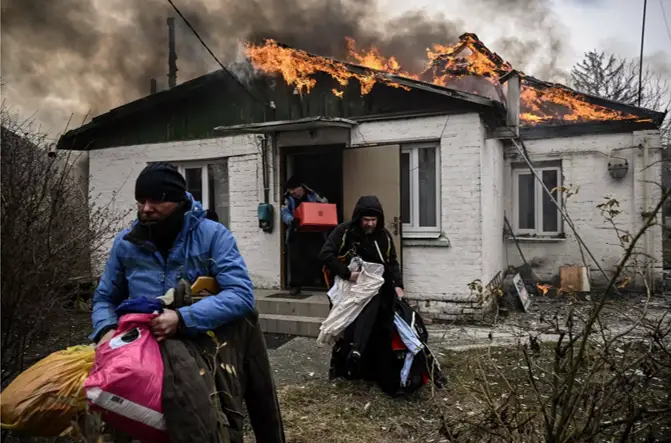As the Russia-Ukraine war grinds into its third year, questions about a potential ceasefire have resurfaced amid shifting battlefield dynamics, economic strain on Moscow, and growing international diplomacy. While neither side has shown public willingness to negotiate, analysts suggest several factors could push Russian President Vladimir Putin toward a temporary pause—or lock him into prolonging the conflict. Here’s a breakdown of the key considerations.
Table of Contents
Pressures That Could Force Putin’s Hand
1. Military Fatigue and Stalemate
Russia’s once-rapid advances have slowed to a gruelling attritional war, with Ukrainian forces reclaiming territory in limited counteroffensives. A prolonged stalemate—or significant setbacks like Ukraine’s 2022 recapture of Kherson—could deplete Russia’s resources, forcing Putin to consolidate gains. Reports of ammunition shortages and reliance on outdated Soviet-era equipment highlight Moscow’s logistical challenges.
“Putin may eventually see a ceasefire as a way to buy time to rebuild his army,” said Tatiana Stanovaya, a Russian political analyst. “But he’ll only do this if he believes the frontlines are sustainable.”
2. Economic Toll of Sanctions
Western sanctions have cut Russia off from global financial systems and slashed energy revenues, its economic lifeline. Though Moscow has adapted by pivoting to Asian markets and ramping up wartime production, long-term isolation risks eroding its industrial base. The G7’s 60/barreloilpricecapalonecostRussiaanestimated60/barreloilpricecapalonecostRussiaanestimated37 billion in 2023, according to the International Energy Agency.
“The economy is surviving, but not thriving,” said Alexandra Prokopenko, a former Russian Central Bank official. “If export revenues keep falling, Putin’s calculus could shift.”
3. Domestic Unrest and Elite Dissent
Public dissent in Russia remains muted due to draconian wartime censorship. However, the 2022 mobilization order triggered rare protests and an exodus of fighting-age men. Meanwhile, sanctions have squeezed oligarchs and elites, some of whom privately question the war’s longevity.
“Putin’s inner circle isn’t immune to frustration,” said Andrei Kolesnikov of the Carnegie Russia Eurasia Center. “If casualties mount without victory, even loyalists may push for an exit.”
4. Diplomatic Off-Ramps
Neutral powers like China, Turkey, and India have repeatedly offered to mediate. Beijing, in particular, has framed itself as a peace broker, releasing a vague 12-point ceasefire proposal in 2023. While Kyiv and the West dismissed it, such efforts could give Putin a face-saving off-ramp.
Why Putin Might Double Down
1. Uncompromising Territorial Demands
Russia insists any deal must recognize its sovereignty over four Ukrainian regions—Donetsk, Luhansk, Zaporizhzhia, and Kherson—which it illegally annexed in 2022. Ukraine, backed by the UN, rejects these claims, creating a near-insurmountable roadblock.
“Putin has tied his legacy to absorbing these territories,” said Samuel Charap of the RAND Corporation. “Backing down would undermine his regime’s narrative of restoring Russian greatness.”
2. Fear of Looking Weak
The Kremlin has framed the war as a fight for Russia’s survival against a “Nazi-led” Ukraine and encroaching NATO. State media pumps out daily propaganda touting battlefield successes, making concessions politically risky.
“Putin can’t afford to look defeated,” said Nina Khrushcheva, a political scientist at The New School. “His authority rests on being the strongman who never retreats.”
3. Western Support for Ukraine
Despite delays in U.S. aid, Ukraine continues receiving advanced weapons, from German Leopard tanks to upcoming F-16 fighter jets. Putin may bet that Western resolve will waver, especially with elections in the U.S. and EU this year.
“If Putin senses the West is tiring, he’ll drag this out,” said retired Lt. Gen. Ben Hodges, former U.S. Army Europe commander.
What Could a Ceasefire Look Like?
Analysts outline three potential scenarios:
- Temporary Humanitarian Pause: A short-term halt for prisoner swaps or aid deliveries, similar to the since-collapsed Black Sea grain deal.
- Frozen Conflict: An armistice cementing current frontlines, leaving occupied territories under Russian control—akin to the post-2014 status quo.
- Conditional Deal: Moscow might demand NATO membership guarantees for Ukraine or sanctions relief, terms Kyiv and the West would likely reject.
The Bottom Line
While military exhaustion or economic collapse could pressure Putin to seek respite, his ideological fixation on territorial gains and fear of weakness make lasting peace unlikely. For now, both sides appear locked in a war of attrition, with the conflict’s endgame hinging on three wild cards: Western endurance, Ukrainian resilience, and whether Russia’s internal stability cracks.
Keywords: Russia-Ukraine war, Putin ceasefire, Ukraine NATO membership, Russia sanctions, frozen conflict.



